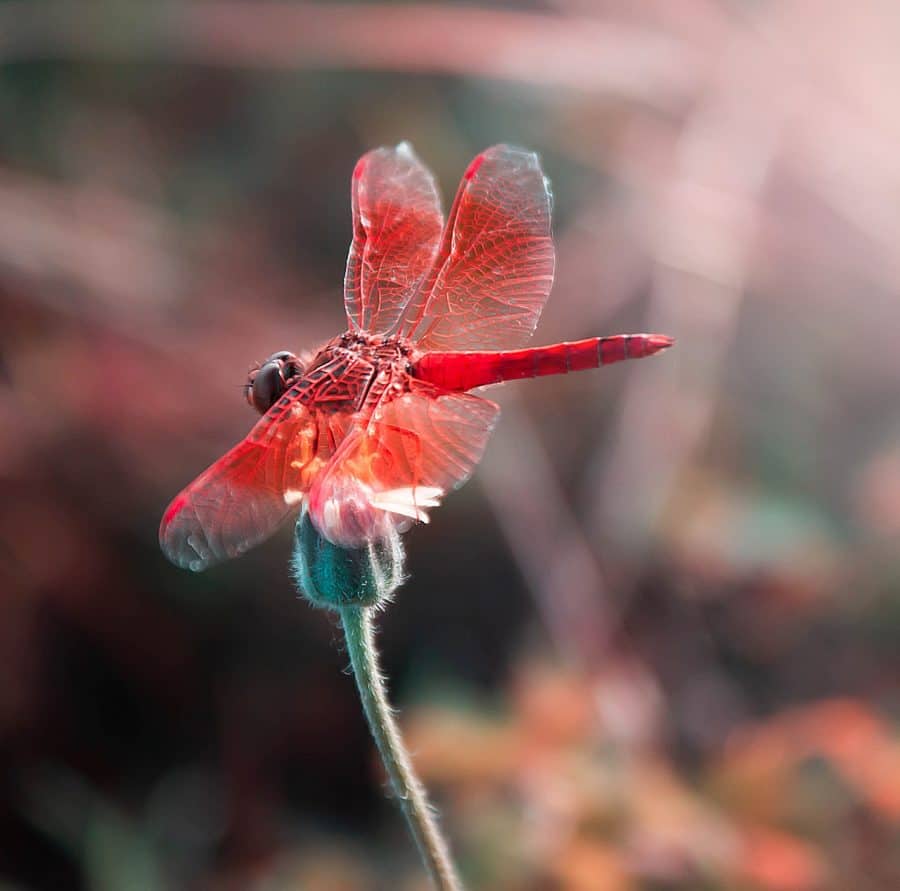
For a garden to thrive and prosper, one needs to provide and nurture a perfect ecosystem. This is especially true of water gardens. In addition to the plants and aquatic life, butterflies and dragonflies are an important component of this delicate ecosystem. This realization set me up on a search for ways to attract these colorful and delicate creatures to my water garden.
So, how does one attract butterflies and dragonflies to a water garden? Add nectar shrubs, include rocks, water feeders, and a combination of sun and shade in your water garden for butterflies. Grass and cattails, rocks, and water lilies also help attract dragonflies.
Balance is essential to any ecosystem. Nature has a way of working towards this. Anywhere we look, there is an established norm where nature reclaims itself and establishes its own rules. In a controlled environment like a garden though, it is obvious that things will be ‘designed’ to suit certain plans. It is very important in such situations to create a system that will help all kinds of biodiversity to exist and flourish.
How do butterflies and dragonflies help a water garden?
Gardens have been designed and built from times immemorial, both personal and public. The need to be in nature’s lap as well as add beauty has prompted this urge to create gardens. Public gardens have necessarily included water features to add to the visual appeal as well as open up avenues for a whole array of aquatic life. Interestingly it is not only water plants and fish that are part of a water garden. Birds of different types as well as butterflies and dragonflies also seek out the water in such gardens.
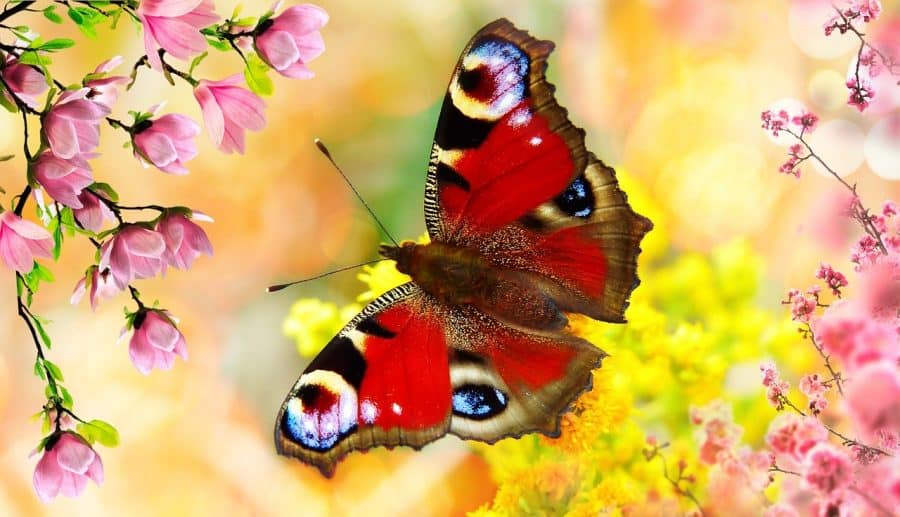
- Add beauty. First and foremost is the beauty that these delicate creatures add to any garden. Flitting past, hovering on flowers, or on the water feature itself, their colorful wings and swift movements enhance the appeal of any garden. They come in myriad colors and sizes. Dragonfly wings have a sheer and shimmery quality and multiple hues that are a delight to watch.
- Enhance variety. These creatures add variety to a water garden. Fish, snails, small turtles, small crustaceans and ducks are some life forms associated with a water feature. Enabling an environment that fosters butterflies and dragonflies adds to this.
- Pollinate. Along with birds like hummingbirds and sun birds, these creatures help in pollination. Colorful blooms in a garden are not only attractive to the human eye, but they are also a big pull for pollinators. Butterflies and dragonflies are more attracted towards nectar-producing blossoms. Whatever the case might be, all of them contribute towards a beautiful garden.
- Eat mosquitoes. It is a fact that any water feature runs the risk of encouraging mosquitoes. Dragonflies are known for their predatory behavior. They feast on mosquitoes and help fight that menace to a considerable extent. It is another matter that they are sometimes predatory towards small butterflies too.
- Eat aphids and waste. The harvester butterfly feeds on aphids and helps keep their population in check. Some other species of butterflies help ridding the garden of rotting fruit, animal excreta or even carrion, thus keeping the environment healthier.
- Provide food. Butterflies and dragonflies are part of a garden ecosystem where they do their bit towards the food chain. They consume smaller insects, mosquitoes, larvae, rotting fruits and carrion. Bigger creatures like birds, fish and lizards in turn make a meal of them. These winged beauties provide food to such species and help maintain the circle of life.
Tips to attract butterflies and dragonflies to water gardens
- Add nectar shrubs. One of the most common sights in a garden, and in people’s imaginations, is a butterfly feeding on a flower. They suck nectar from flowers that provide food for them. It is important to choose nectar-producing flowering plants and shrubs that flower throughout the year. This will help attract butterflies through the year. Some such plants are milkweed, Brazilian verbena, lantana, butterfly bush, lavender, mint, and butterfly weed, among others.
- Flat rocks. Both butterflies and dragonflies love basking in the sun on flat surfaces. Keeping flat rocks with large surface area around your garden will help serve this purpose. Rocks tend to become hotter in the sun compared to vegetation in a garden. Even water surfaces including your water feature will feel cool to them. In contrast, a flat face of rock provides these cold-blooded creatures the necessary amount of heat and sun to ‘bask’ in.
- Water feeders. It is a common sight to see butterflies and dragonflies hovering over water surfaces in a garden. Both these creatures love drinking water on and off through the day. What then is the purpose of a water feeder, you might wonder, especially in a water garden! A water garden already has a water feature, so is a feeder really needed? Actually, yes! There are two reasons why a water feeder is a better option for attracting these creatures. Firstly, there may be fish, frogs and birds in a water feature predatory towards butterflies and dragonflies when they come to drink water from the water feature. Secondly, a water feeder can supply additional nutrients like sugar water to them. Other things like overripe fruits, tree sap or animal manure is also food for butterflies and these maybe ‘served’ in the feeder too.
- Sun and shade. Create a combination of sun and shade in your water garden for butterflies and dragonflies. Both of these creatures love their share of the sun as well as periods of rest in some shade. Butterflies are known to feed best when it is a bright sunny day. Areas that receive a lot of sun seem to beckon them. On the other hand, dark nooks and crannies in garden rocks normally tend to be moist and are preferred rest places for butterflies.
- Go for right vegetation. Dragonflies love tall grasses, cattails, and water lilies. I am sure a lot of us reading this have observed dragonflies swishing gracefully among tall grass, perching on some, passing others by in a happy swirl. Go right ahead and make space for the same in your garden and watch them visiting in large numbers. Cattails and water lilies may easily be grown in a controlled fashion in your water garden to encourage dragonflies.
- Butterfly spas. This is a fancy name for providing a place for butterflies to ‘puddle’. This basically means a shallow place that has damp sand or mud where butterflies like to ‘hang out’. They enjoy just wallowing there, drinking little water and mineralizing at these spots. You can do this by simply placing sand and a little water in shallow pans and putting them out around your water garden. Alternatively you can always shop around for fancy ones and attract these flying beauties to your garden.
- Grow native plants. It can often be a temptation to grow exotic plants in your garden. These are a visual delight as well as fruition of a challenge at times. The fact that a certain plant is thriving in a foreign environment can be quite a thrill. However that might be, it is native plants that attract local creatures more easily. Keep this in mind if you wish to encourage butterflies and dragonflies.
- Invest in bright colors. Butterflies are attracted to bright colors. Choosing the right colors will draw in butterflies to your garden. Colors like yellow, orange, red, pink and purple are like magnets for them. Make sure your garden has blooms in these colors. Another point to be noted is the shape of the blooms. It is easier for butterflies to perch on flat-topped blooms.
- Plant milkweed. Monarch butterflies eat from milkweed plants. This is a way to encourage these endangered butterflies as well as other species of butterflies. However there are different types of milkweed plants that grow depending upon the region. It is best to consult with an expert in order to find the right one for your water garden.
- Avoid insect traps. Electronic insect traps are often installed in gardens to deal with the mosquito menace. This is especially true of water gardens which provide an environment for mosquitoes to breed. However these traps are detrimental to winged creatures like butterflies and dragonflies. Their wings tend to get caught easily. It is better to avoid such traps if one wishes to attract butterflies and dragonflies.
- Go easy on pesticides. Gardens will attract pests of different kinds, more so a water garden. Some pesticides, however, are harmful for butterflies. It is best to avoid malathion, diazinon and Sevin in gardens. This will help with the butterfly population. One may explore organic options, nets, sound-based repellents or certain flowers that act as deterrent for pests.
- Mutual dependence. Dragonflies are predatory in nature and butterflies are often their target. It is no surprise that a garden that has lots of butterflies will automatically attract dragonflies. It is not only the water feature that pulls them but also the lure of feasting on an occasional butterfly. This is how nature works and there is a food cycle to sustain. If in the process butterflies bring in dragonflies, so be it.
- Avoid fish. Fish and dragonflies work at cross purposes in terms of the reproductive cycle of the latter. Female dragonflies lay eggs in damp areas around edges of a water feature. Fish love to feed on nymphs that hatch from these eggs and can be a dampener to the dragonfly population. In case you want to feature fish in your water garden, it would be a good idea to make provision for a separate small water body to encourage dragonflies to lay eggs away from predatory fish.
- Keep the water clean. Dragonflies prefer to breed in clean habitats that are pollution free. In fact presence of dragonflies is testimony to the health of your garden and surroundings. Keeping your water feature clean and free of pollutants will help attract dragonflies.
- Encourage some undergrowth. Butterflies grow out of caterpillars. Keeping your garden free of weeds is all very well, but then what will caterpillars feed on? Keep a designated area of your water garden for this purpose. Let the grass grow a bit around the edges at these places to encourage caterpillars.
- Build shelter. Butterflies and dragonflies are cold-blooded creatures. Both of them enjoy the sun. However, they need a place to go to when it is raining. A garden is sure to have large leaves to shelter them. However, you may do your bit by adding brightly-colored butterfly shelters in your garden. Adding some nectar and/or fruit will help lure them in when it is raining outside.
- Provide a slope. Since you already have a water garden, half your job is done with attracting dragonflies. They love hovering over water and perching on cattails. When you design your water garden, bear in mind that dragonflies love slopes and shallow edges to lay their eggs in. Build in sloping edges to encourage their reproduction.
- Butterfly- and dragonfly-specific plants. It has been found that certain plant species act as natural food sources for butterflies. There is an entire list of such plants designated by the National Wildlife Federation. We will look into some of them in detail in the following segment. It is a good idea to plant some of these in accordance with weather conditions in the region where you are. Long shrubs and plants along the perimeter of gardens encourage young dragonflies to hide in.
Plants that attract butterflies and dragonflies
Preservation and prosperity of life forms is essential to maintain the balance of nature. Research has shown that bees are decreasing in number worldwide due to loss of habitat and that this has far-reaching consequences. Not only will this have repercussions on the animal world but it is also projected to have an impact on human life as well. In the same vein, some butterfly species are also facing endangerment. The magnificent Monarch butterfly is a case in point. It is important that people who have gardens do their best to promote butterfly populations. Growing plants that help is the right step in this direction.
Depending upon which part of the world you are in, following National Wildlife Federation guidelines about this helps. Following is a list of some plants that help attract butterflies:
| Buckwheat | Dill | Prickly ash | Milkweed | Wisteria |
| Everlast | Chicksaw plum | Azalea | Thistles | Sassafras |
| Dragon sagebrush | Purpletop grass | Mistletoe | Saltbush | Peas |
| Parsley | Willow | Blueberries | Aspen | Violet |
| Sycamore |
There are also a number of plants that attract dragonflies. The table below are some of them:
| Black-eyed Susan | Swamp milkweed | Joe-Pye weed | Meadow sage | White yarrow |
| Arrowhead celery | Cattail | Water lily | Water horsetail | Dwarf sagittaria |
Some of these plants have beautiful blooms, some are usable in kitchens, and others just look good. More importantly they all add value to the cause of butterflies and dragonflies around water gardens.
Does garden lighting affect butterflies and dragonflies?
There has not been definitive study and enough data to support or discourage the use of artificial lighting and how it affects butterflies. As is well known, butterflies and dragonflies are daytime creatures, while moths come out at night. At least that is how nature intended their roles to be. Their colorful appearances tell the story as opposed to the duller appearance of moths. And there is the old saying, ‘like moths to a flame’; we never say this for butterflies. Flames are lit in the dark and moths are creatures of the dark.
With increase in artificial lighting and extended outdoor activities in bright lights, it is not unusual these days to see butterflies fluttering around after dark. They are completely lost in the dark and sadly cannot make out the difference between night and day. In the long run this can disturb their foraging and reproductive habits in a way that is detrimental to their healthy survival. As responsible people, we need to be aware of this aspect. Nurturing and creating the right ambience will help maintain the garden ecosystem and encourage harmonious coexistence of all living things in and around your water garden.
Role of dragonflies in mosquito containment near water bodies
Water features tend to become breeding grounds for mosquitoes. While a water garden has an appeal of its own, mosquito menace is for real and has to be dealt with. There are different means to tackle this problem:
- Chemical.
- Natural.
- Physical.
When the objective is to attract butterflies and dragonflies to a water garden, the first and third options listed above become irrelevant. As we have discussed above, specific chemicals are not advisable to be used in case you wish to promote butterflies in your garden. Physical options like electronic pest catchers are okay for mosquitoes and houseflies but detrimental to butterflies and dragonflies. They tend to get trapped in these and die due to damage to their wings on most occasions.
The natural option seems best in this context and provides a viable solution. Along with fish like guppies, dragonflies are a wonderful natural means of controlling mosquito population in water gardens. They are known to feast on mosquito larvae in great numbers. In addition, they also predate adult mosquitoes in the air. There could not be a better natural means of mosquito control in a water garden.
Chemical usage and butterflies/dragonflies
Gardens will have pests, period. Many of them cause damage to gardens and take a huge toll on decorative plants and rare species. This necessitates the use of chemical means to control and/or obliterate pests. Insecticide solutions, sprays and bullets are used in gardens worldwide to curb insect menace. While they are very effective in this regard, the chemicals used have a sweeping effect on other insects and life forms. Butterflies and dragonflies are an example of this.
There is a very interesting angle to this topic in the sense that butterflies emerge from caterpillars. And caterpillars are definitely pests for any garden. They consume leaves in enormous numbers and pose a challenge to gardeners. Wholly terminating them with the use of insecticides will stop the destruction of leaves but will also kill caterpillars directly and affect butterfly population in the garden as well. It is a fine line to tread.
Some ways to deal with pests while protecting butterflies and dragonflies in your water garden are enumerated below:
- Avoid using insecticides toxic to butterflies like malathion, diazinon and Sevin.
- Use pesticides after dark when butterflies and dragonflies are not active.
- Apply pesticides after checking wind direction to control their spread.
- Pick out caterpillars manually and drop them into a pail of soapy water to dispose of them.
- Avoid lighting your water garden for long hours in the dark since this may attract moths.
- Companion planting discourages caterpillars and mosquitoes. Plant strong-smelling varieties like lavender, mint and sage to counter the pest menace.
- Use netting to cover your plants at times. This will give them access to air, water and sunlight while containing caterpillar attacks.
Why are butterflies and dragonflies vital to the ecosystem?
Butterflies and dragonflies contribute their bit to the environment. And ‘bit’ is an understatement by any measure. Adding beauty to any garden is only part of their job. Their presence, numbers and health are significant environmental indicators. Both of these creatures form an important link in the food chain. It is vital to ensure their populations do not dwindle in order to maintain the status quo of nature. Every nature lover can thankfully contribute to this cause by doing their bit to ensure that optimal conditions are made available.
Butterflies: These winged creatures are a sure way to know how healthy a particular environment is. Their lackluster presence or complete absence will be enough to foretell that all is not well with a garden. Not only does their absence indicate excessive pesticide usage but also climatic changes. Butterflies are an essential part of the food cycle in any garden. They are food for birds, lizards and spiders that are an integral part of any thriving garden. Naturally a decline in butterfly population is bound to upset this entire chain.
Scientists can gauge the health of an ecosystem from studying migratory patterns of butterflies. Drastic and sustained changes in temperature and rainfall patterns affect butterfly populations. With global warming and unpredictable weather patterns becoming more common, these delicate creatures are facing an uncertain future. By extension, so is a large part of the ecosystem. Loss of habitat is a major reason behind dwindling butterfly populations. It should be the endeavor of any conscious gardener to offer them an environment that will boost their population.
Dragonflies: These beautiful creatures are known to thrive in clean environment and non-polluted waters. Their predatory nature helps account for garden pests and keeps the ecosystem balanced. More importantly, their propensity to shun places that are polluted is a great indicator of the place. Absence of dragonflies from a garden would be a wake-up call to get one’s act together and clean up the surrounding space.
They not only indicate the biophysical conditions but more specifically, the health of your water feature. They need healthy aquatic plants to provide them enough hiding places as well as a steady supply of oxygen for their survival. Dwindling numbers of dragonflies will immediately indicate that all is not well with your water garden.
Making your own butterfly feeder
While there are many options for butterfly feeders available online, one can easily make these at home. All you need are basic ingredients like a jar with lid, sugar, water, a piece of sponge, string and nails, a pair of scissors and a saucepan.
- Prepare butterfly food. Mix water and sugar in a ratio of 9:1 in a saucepan. Put it on a stovetop and let it come to a boil until sugar dissolves. Set the solution aside to cool.
- Make a small hole in the lid of the jar. This will hold the sponge in place.
- Push a piece of sponge through the hole. It needs to be halfway out and fit tightly at all times.
- Add colorful flower shapes to the feeder. The more colorful you make it, more chances for butterflies to flock.
- Make a hanger using string. See that the jar sits straight after you have secured the strings.
- Drive a nail through where you want to hang the feeder. It should be located at a height that is above the flowers and easily visible.
- Fill in the sugar solution into the jar now and tighten the lid with part of the sponge submerged into the solution and part sticking out.
- Hang your colorful butterfly feeder and watch the beautiful creatures flock to it.
Recommendations for devices to attract butterflies and dragonflies
Along with planting the right trees and providing correct environment for butterflies and dragonflies to prosper, there are some means and devices that can attract butterflies to a garden. From puddling stones to butterfly houses and milkweed seed balls, here are a few recommendations to help the cause:
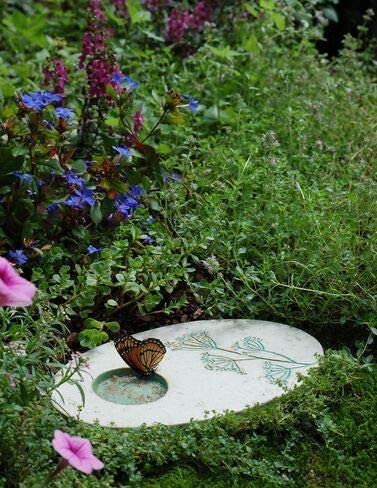
Outdoor Butterfly Puddling Stone – Butterflies love puddling in soft wet sand around gardens. Providing a place for them to do so ensures that they get the necessary minerals as well as spend time sunbathing. While it is easy to DIY, a beautiful ceramic puddling stone will only add beauty to your garden. All you need to do is to fill it with sand, pinch of salt and water and leave to dry in a sunny place. Buy it from Amazon here.
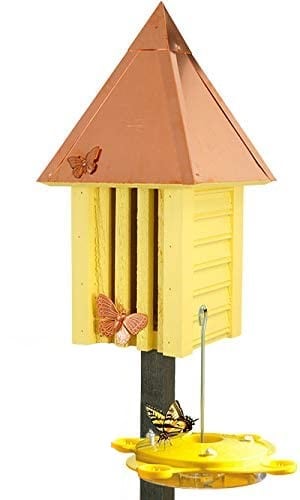
BestNest FlutterBye Butterfly House – Add an element of attraction for butterflies in your water garden with a butterfly house. This comes with a feeder. It comes in an attractive color combination too. The accompanying feeder can hold 12 ounces nectar as well as fruits to lure these creatures. Available from Amazon here.
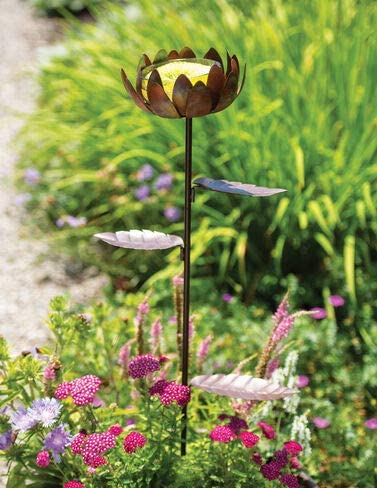
Gardener’s Supply Dahlia Butterfly Feeder – A thing of beauty, this feeder comes in the shade of a blooming dahlia. It has a sponge to soak up butterfly nectar (not included) and the petals give a place for butterflies to perch while feeding. Available from Amazon here.
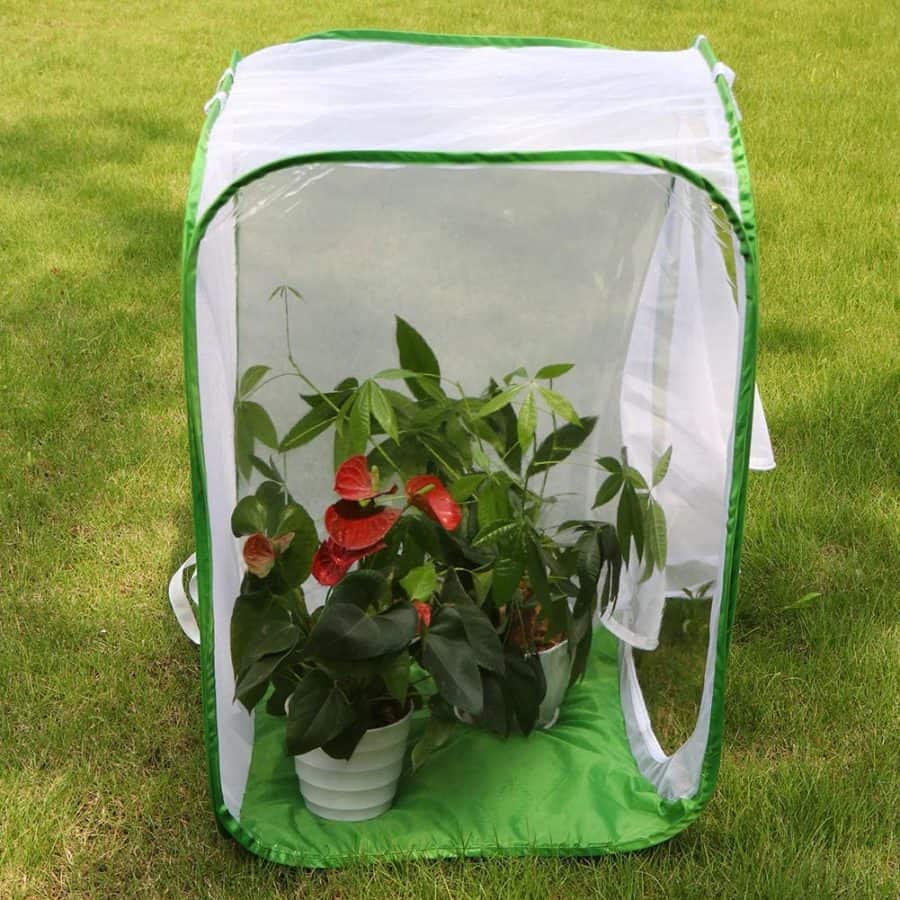
Restcloud Monarch Butterfly Collapsible Mesh Cage Habitat – Designed with the aim to promote endangered Monarch butterflies, this is a square mesh cage with a easy-to-clean polyester bottom. The width and height allow space for milkweed plants within. Clear mesh windows make it easy for people to view the process of caterpillars forming chrysalides and onto beautiful Monarch or Black Swallowtail butterflies. Available here.
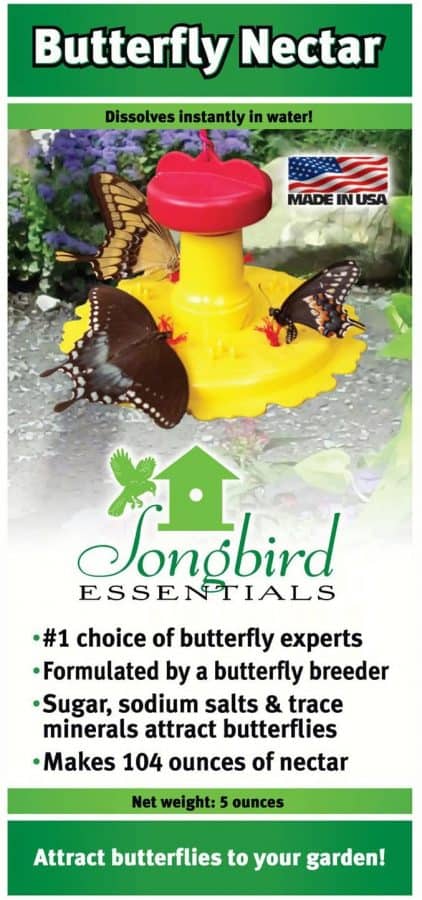
Songbird Essentials Butterfly Nectar – Nectar is food for butterflies. This comes in an easy to use form with essential nutrients added. Ensure good health for the butterflies in water garden with this product. It contains dextrose, sucrose and sodium salts too. Buy it here .
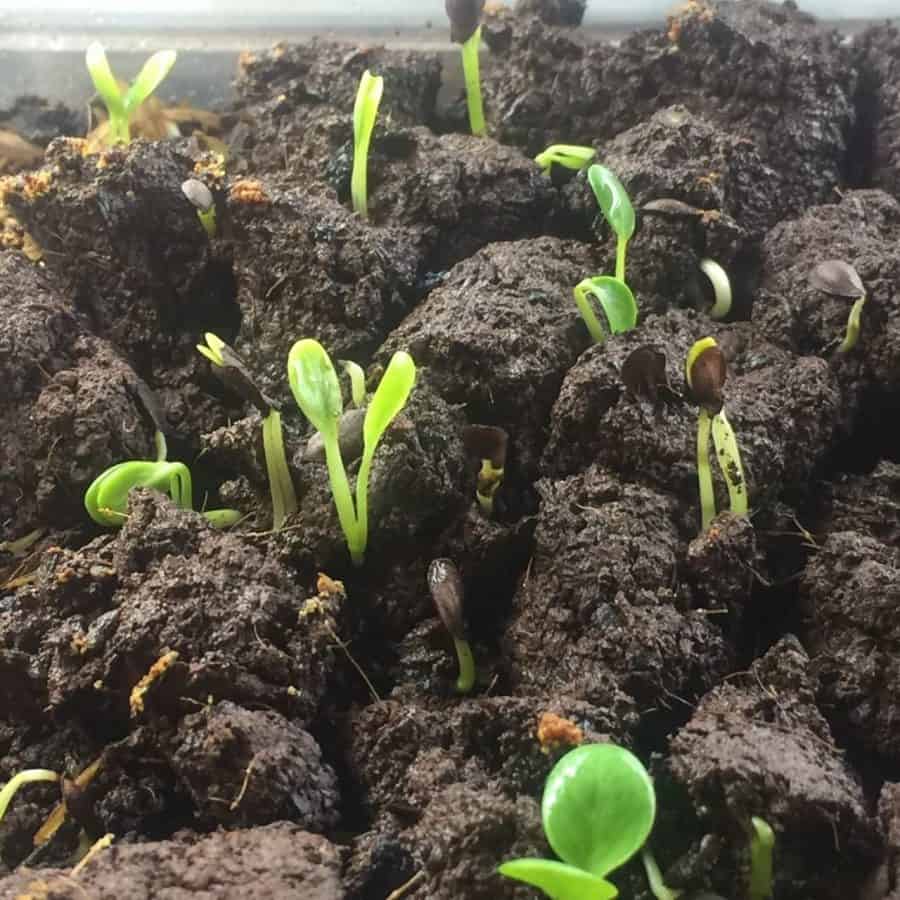
Butterflyweed Guerrilla Milkweed Seed Pellets – Milkweed is the favorite for Monarch butterflies and many other species of butterflies as well. These come in the form of pellets and are ideal for guerrilla gardening. Give your butterfly population a boost. You can purchase these pellets here.
Related questions
What risks do water gardens pose?
Although incorporated as pleasure features, water gardens need constant maintenance. Lack thereof might lead to uncontrolled growth of flora/fauna, affecting the ecological balance. Absence of proper lighting may potentially cause accidents or slippages in the dark.
What kinds of aquatic life thrive in a water garden?
Along with various aquatic plants and different kinds of fish, there are algae, small crustaceans and snails in water gardens. Lizards, turtles and frogs also visit water gardens. Some people might also introduce ducks if the water garden is big enough. The possibilities are endless.